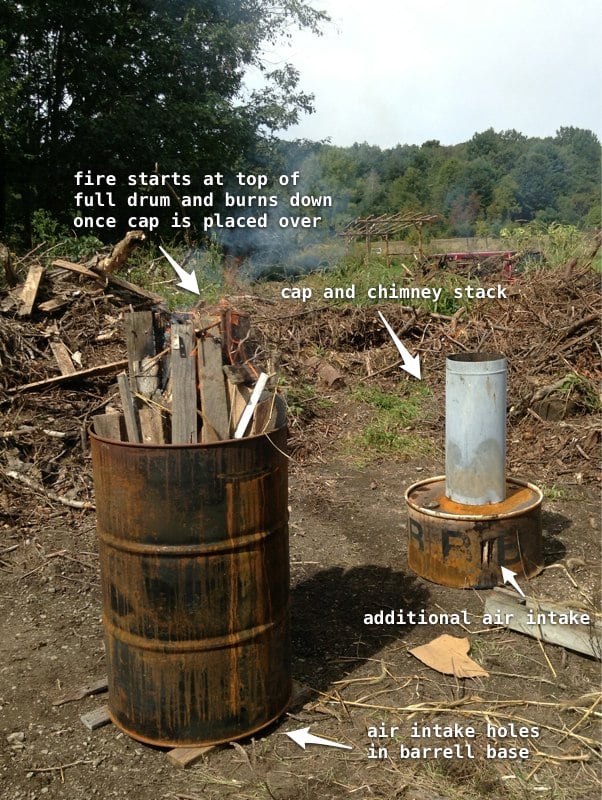Small-scale, simple and accessible Biochar production may be a key component in grassroots paths to ecological sustainability.
Charcoal production for soil amendment is an attractive option for horticulturists in many growing conditions, if suitable feedstock is readily available. Charcoal is quite stable in the soil, and will sequester the constituent carbon from returning to atmospheric CO2 (the result of natural decomposition) for periods of hundreds to thousands of years. The heat generated during the charcoal kilning or firing process may be captured or applied in various ways for modest advantage, as appropriate.
While elaborate, custom, high-volume systems have been designed and implemented, it is very possible that the greatest quantity of biochar production in coming years will be from small, simple, low-cost, semi-mobile systems assembled in 'DIY' fashion from available materials.
The following project description documents one such highly replicable model, based on the common 55 gallon steel drum.
Theory
Heat woody feedstock in a low oxygen environment until thoroughly charred:
Option 1 retort method - heat an enclosed, non-ignited volume of feed stock material to 5-700 degrees until charred.
Option 2 rocket stove type - burn the feed stock itself in a low-oxygen TLUD (top loading up draft) stove unit, arresting full combustion.
Although somewhat lower efficiency and quality (due to higher temperatures and more air flow), Option 2 is used here for simplicity.
Design
The basic unit consists of a cylindrical burn chamber, with a removable chimney cap. A single common 55 gallon steel drum is recommended. This design utilizes the top 1/3 of a second drum plus a two-foot length of 12" stove pipe for the cap assembly, allowing for a slightly taller load volume.
The key to proper airflow is two-fold:
1. a set of approximately 40 holes 1/2" diameter are drilled into the bottom of the main drum for primary (updraft) air intake
2. several slots, or other opening, are created in the cap piece or in the ring where it meets the top of the main drum for additional air intake, creating an after-burn effect in the chimney where volatile gasses escaping from the wood below (syngas) will combust, reducing emissions.
Operation
The drum is placed on a low stand (to allow good air inflow) and loaded with feedstock of relatively uniform cross-section so as to minimize air pockets without restricting air flow. Logs and branches over about 4" diameter may not be suitable in this unit.
A fire is kindled at the top of the open loaded drum, until a good blaze has begun to spread through the exposed material. Then, the cap piece is fitted over this fire to create a substantial draft through the chimney column.
The unit is left to burn down from top to bottom, leaving charred wood above as the fire moves downward since all available oxygen is consumed at the burn line. This may take from one to three hours in a full drum. Heat can be captured from the exhaust column during combustion via water coil or other means.
While the fire burns downward, its progress can be monitored by testing the temperature of the outside drum walls at different heights with a splash of water. When full combustion temperatures reach the bottom of the unit, the cap is removed from the drum and the fire is quenched with water.
The drum is tipped and emptied on the ground, any hot spots are extinguished, and the pile may be spread out to ensure cooling before adding it to any other charcoal stockpile.
Results
One full drum will result in around 1/2 the volume of charcoal, of much lesser weight. Some incompletely burned pieces may need to be recycled through another burn. If the feed stock is of larger size, the resulting charcoal may need to be crushed or screened to 1/2" size pieces or smaller before working into soil. Be aware that charcoal dust is damaging if inhaled.
Variations
- Folke Günther's "the simplest of the simple" two-barrel charcoal retort
